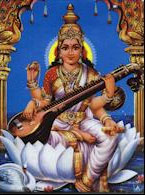
Basant Ritu (season) is supreme from all the other seasons as this season comes after the intense heat of the summer, from the shivering colds of the winter and from the mayhem of rain. The whole ambience turns mustard yellow and the time to celebrate the spring festival of Basant Panchmi arrives.

During this auspicious time (above) Goddess Saraswati, the Goddess of wisdom, knowledge and intellect is revered and homage is paid to her by intellectual Pundits and students of all arts, science, music and dancing. Basant is also important because Lord Krishna himself has described this as a flowering season in magnificence.
This festival is celebrated on the fifth day of dark lunar days in Magh (February) and the worship of Goddess Saraswati has been prominent since the Vedic and the Puranic eras. It is said that Lord Brahma manifested Saraswati on this day so that the creation enjoyed a life of intelligence, harmony and dialogue. A beholder of the musical instrument Veena and called “Veena Vandini” and “Vani Dayyanni” she bestows the art of music and speech to the people of this world.
The humans alone do not worship Saraswati but the Gods also revere her and ask for her grace in advancing their own prowess in their spiritual dealings within themselves and with humans. So on this day the Goddess is worshipped with great fervour by all with fragrant flowers and powdered sandalwood. In the olden times the children were given ‘Guru dakshina’ (acceptance of the student by a teacher) in an ‘Ashram’ (school) or ‘Guru Kul’ on this auspicious day.

It is said that Lord Krishna (above) also worshipped the Goddess on this day and She bestowed the sixteen ‘kalaas’ (16 arts) on him. On this day in many parts of India poetical symposiums, music festivals, art and craft seminars and dramas are held  and the artistes rewarded for their brilliant achievements.
and the artistes rewarded for their brilliant achievements.
Basant Panchmi is the festival, observed on a large scale in Punjab and the North when the mustard crop is ripe. The people put on yellow garments. They cook yellow rice. The famous folk dance 'Bhangra’ of Punjab glorifies the congregations on this festival. This is a festival of jubilation when the farmers are rich with their yield.
Basant Panchmi or Vasantotsav, the ancient festival of spring in south Asia, brings festivity, singing, dancing, and beautiful colours everywhere. The yellow of mustard flowers covers miles on end in much of rural north India. Even though Basant Panchmi is considered primarily a Hindu festival, it may come as a surprise to many that a large number of North Indian Muslims too celebrate it, especially those in Sufi dargahs such as that of Hazrat Nizamuddin at New Delhi. Some interesting legends are associated with 13th century poet Amir Khusro and saint Nizamuddin Aulia for the genesis of Basant celebration amongst muslims. There are many historical accounts of medieval India that talk of the pomp and revelry with which it was celebrated, and even supported by Mughal rulers such as Bahadur Shah Zafar and others.
Compared to the glitter of Basant in the past, we may have lost some of the vibrant traditions in the cities, but in the Dargah of Nizamuddin at Delhi, one can still find some festivities and rituals associated with Basant. In the morning of Basant Panchmi, some qawwals from Dargah visit a nearby Haryana village to collect mustard flowers. On the way back they offer them first on the tombs of many saints related to Nizamuddin Aulia’s order, including Naseeruddin Chiraghe-Dehli and others near Mehrauli. Back in Basti Nizamuddin, clothes are being dyed in the Basanti colour which is basically the yellow colour of mustard flowers. One can see hundreds of people wearing Basanti scarves, handkerchiefs, chadurs and caps, dancing to the tune of Basanti qawwalis. They offer the flowers and fateha (prayers) on every little grave present there. The beautiful Hindi and Persian qawwalis sung here - mostly ascribed to Amir Khusro himself - praise the coming of spring and the disciple's longing to meet his guru or pir.

For Namdhari Sikhs the importance of Basant Panchmi is the avtaar (birth) of Sri Satguru Ram Singh Ji, the founder of the Namdhari Khalsa Panth. He was born on the basant panchami day - Thursday, 3rd February of AD 1816. (Maghsudi 5, 1872
bikrami). Satguru Ji's parents were Baba Jassa Singh Ji and Mata Sada Kaur Ji.
Twenty five kilometres from Ludhiana is located a small village of Sri Bhaini Sahib which embodied a rural life typical in the land of the five rivers. Around its fields, there existed a corporate life led by simple, God-fearing and innocent people. In Such a village was born the great Guru of the Namdhari Sikhs in the year 1816. This was the day when the fields were green with the crops and the yellow flowers were dancing majestically from the stems of the plants.